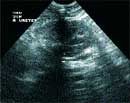Treating urinary tract infections can take time
Signalment: Canine, Greyhound, 2.5 years old, female spayed, 65 lbs. Clinical history: The dog has a persistent urinary tract problem ? hematuria for at least one year according to the owner. The dog improves with antibiotics, but once finished, hematuria starts again. Therapy has included Clavamox.
Signalment:
Canine, Greyhound, 2.5 years old, female spayed, 65 lbs.
Clinical history:
The dog has a persistent urinary tract problem - hematuria for at least one year according to the owner. The dog improves with antibiotics, but once finished, hematuria starts again. Therapy has included Clavamox.

Image 1.
Physical examination:
The findings include rectal temperature 101.8° F, heart rate 124/min, pink mucous membranes, and normal capillary refill time. The dog is bright, alert, and responsive. Normal heart and lung sounds are heard.
Laboratory results:
A complete blood count, serum chemistry profile, and urinalysis were performed and are in Table 1.

Image 2.
Radiograph examination:
The lateral abdominal radiograph shows gaseous distension of the intestinal tract.
Ultrasound examination:
Thorough abdominal ultrasonography was performed.

Table 1: Results of laboratory tests.
My comments:
The liver shows a decreased inhomogeneous texture in its parenchyma. No masses noted within the liver parenchyma. The gall bladder is mildly distended, and its walls are not thickened or hyperechoic.
The spleen shows a homogeneous to inhomogeneous texture in its parenchyma - no masses noted. The left and right kidneys are similar in size and shape. The left kidney shows a decreased echogenicity in the renal cortex; the right kidney shows an inhomogeneous texture in the renal cortex. The ureter as it originates from each kidney is prominent and dilated. No masses or calculi were noted in either kidney. The urinary bladder is distended with urine and contains some urine sediment material - no masses or calculi noted.

Image 3.
There are blood clots attached to the urinary bladder wall. When the dog changed position, the right ureter was clearly seen as it enters the urinary bladder. The left and right adrenal glands are similar in size and shape.
The stomach, small intestines and colon are normal. The pancreas shows decreased inhomogeneous texture in its parenchyma.

Image 4.
Case management:
In this case, ascending urinary tract infection contributing to recurrent pyelonephritis is the clinical diagnosis.
The way I generally manage recurrent urinary tract infections as in this dog is as follows.
First, I diagnose and manage any underlying cause for the problem. Then, I administer appropriate antibiotic therapy (such as daily Baytril, Orbax or Zeniquin) to the affected dog until the urine cultures negative, which usually requires standard antibiotic therapy for at least four to six weeks.

Image 5.
Thereafter, the dog receives a single standard dose of the respondent antibiotic each evening after complete emptying of the urinary bladder for the night, usually for most people around 10 to 11 o'clock.
With administering the antibiotic agent to the dog each evening it should concentrate in the collecting urine during the night for an immediate antimicrobial effect and should help maintain a delayed antibiotic effect that is known to occur with many antibiotic agents in the urinary tract.
This means that the antibiotic agent will be incorporated into the surface epithelial cells of the urinary tract and maintain a bacteriostatic effect for an extended time period, which will vary with the antibiotic agent used. How long one should use the daily evening dosing of an antibiotic agent for recurrent urinary tract infection is unknown. It may be for months to years depending somewhat on the medical history and active clinical problems of the affected dog. I suspect some recurrent urinary tract infections are related to impaired immune regulation in the urinary tract, and these types of cases may require antibiotic therapy for life.

Mississippi State renovates internal medicine ward
Dr. Hoskins is owner of DocuTech Services in Baton Rouge, La. He is a diplomate of the American College of Veterinary Internal Medicine with specialties in small animal pediatrics. Formerly a professor in the School of Veterinary Medicine at Louisiana State University, Hoskins is also the author of clinical textbooks on pediatrics and geriatrics. He founded an Internet service called "Vet-Web.com", where pet owners can e-mail animal health-related questions and he responds via e-mail. The Internet address is www.vet-web.com. He can be reached at (225) 751-9272.